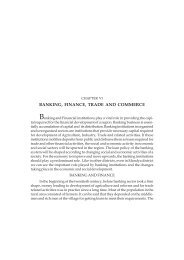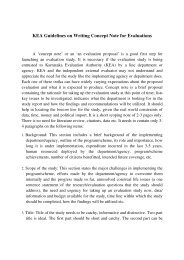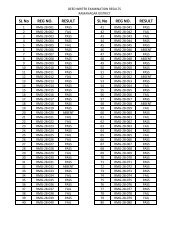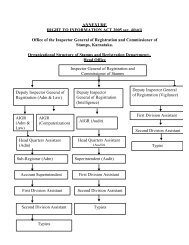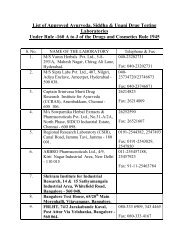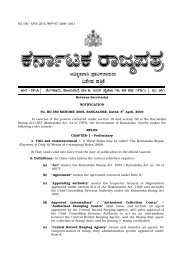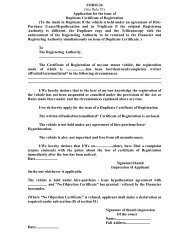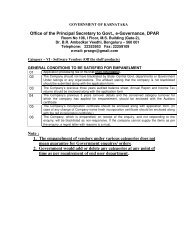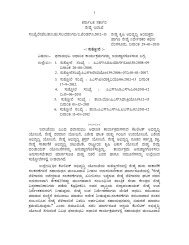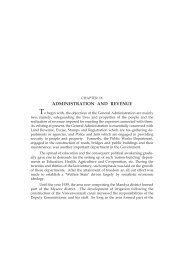Chapter XIII CULTURE - Government of Karnataka
Chapter XIII CULTURE - Government of Karnataka
Chapter XIII CULTURE - Government of Karnataka
You also want an ePaper? Increase the reach of your titles
YUMPU automatically turns print PDFs into web optimized ePapers that Google loves.
Culture 507<br />
Sriranga has been a pioneer in this field. He has about 45 plays to his<br />
credit and all his plays reflect social situations in the state. ‘Harijanavara’,<br />
‘Prapancha Panipattu’, ‘Sandhyakala’, ‘Shoka Chakra’, ‘Kelu Janamejaya’, ‘Nee<br />
Kode Naa Bide’, ‘Swargakke Mure Bagilu’, and ‘Agnisakshi’ are some notable<br />
plays <strong>of</strong> Sriranga. The contributions <strong>of</strong> others are equally significant. Among<br />
them G.B.Joshi, Girish Karnad, P.Lankesh, Chandrashekara Kambara are very<br />
important. Some plays worthy <strong>of</strong> mention <strong>of</strong> these writers are Sattavara neralu,<br />
‘Ma Nishada’, ‘Hayavadana’, ‘Anju Mallige’, ‘Hittina Hunja’, ‘Kranthi Bantu<br />
Kranthi’, ‘Sangya Balya’, ‘Baka’, ‘Neralu.’, ‘Neeli Kagada’, ‘Jokumaraswamy’<br />
etc.<br />
Recent theatre enthusiasts like B.S.Venkataram, Prasanna, H.K.<br />
Ramachandra Murthy, G.Shivanand, C,R. Simha and Ka.Vem. Rajagopal<br />
adopted or translated many English plays <strong>of</strong> Brecht and staged them. In the<br />
1980’s theatre enthusiasts like B.V.V. Raju, Srinivasa Raju, T.N. Seetharam,<br />
Vishnu Kumar, ‘Shudra’ Sreenivasa and D.R. Nagaraj have been successful<br />
in carrying the theatre tradition forward. B.V.V.Raju’s ‘Sandarbha’ and<br />
‘Sannivesha’, T.N. Seetharam’s ‘Asphota’, Sreenivasa Raju’s ‘NaleYaarigu Illa’,<br />
‘Yarillige Bandavaru’ and Vishnu Kumar’s ‘Donkubalada Nayakaru’ have made<br />
them famous. The theatre movement has reached all districts centres while it<br />
was restricted to Mysore, Dharwad and Bangalore initially. Young directors like<br />
M.S.Prabhu, R. Nagesh,T.N.Narasimhan, C.G. Krishnaswamy and veterans<br />
like Prasanna and Jayashree are in great demand. K.V. Subbanna <strong>of</strong> Heggodu<br />
near Sagar has won the prestigious international Ramon Magsaysay award<br />
for fostering the development <strong>of</strong> culture. This is a feather in <strong>Karnataka</strong>’s cap.<br />
In the past decade, the theatre movement has undergone a sea-change. It<br />
failed to sustain the interest <strong>of</strong> the audience and the plays folded up with<br />
a whimper. Several important theatre personalities migrated to cinema and<br />
many others went out <strong>of</strong> Kamataka in search <strong>of</strong> greener pastures. To overcome<br />
this gloom, several trends came to the fore in this decade. Stage versions<br />
<strong>of</strong> popular Kannada novels, short stories and even poems, appeared on the<br />
scene, ‘Chomana Dudi,’ ‘Karimayi’, ‘Tabarana Kathe’, ‘Odalala’, ‘Samskara’,<br />
‘Chidambara Rahasya’, ‘Chikaveera Rajendra’, ‘Kakana Kote’ ‘Kalki’, ‘Helathena<br />
Kela’, ‘Saviraru Nadigalu’, ‘Vaishaka’, ‘Kusuma Bale’, ‘Bhoomigeetha’, ‘Kindari<br />
Jogi’, ‘Mookajjiya Kanasugalu’ etc., were staged.<br />
Another trend was the one-man-show by C.R. Simha in 1983, titled ‘Typical,<br />
T.P.Kailasam’. Its success encouraged several similar attempts like ‘Neegikonda<br />
Samsa’, ‘Shakespiyarana Swapna Nowke’, ‘Rasa Rushi-Kuvempu Darshana’<br />
etc., came to light.<br />
During this period several plays reached their hundred show-mark and<br />
notched up a rare feat in Kannada amateur theatre. Benaka’s ‘Sattavara Neralu’,<br />
Kalagangothri’s ‘Mukhya Manthri’, Ranga Sampada’s ‘Sangya Balya’, Yashaswi<br />
Kalavidaru’s ‘Samsaradalli Sarigama’, Sanketh’s ‘Nodi Swamy Naavirode Heege’,<br />
and ‘Nagamandala’, ‘Nataranga’s ‘Tughlaq’, Vedike’s ‘Typical T.P.Kailasam’.<br />
Several other institutions and dedicated theatre people at different centres<br />
<strong>of</strong> <strong>Karnataka</strong> are doing very useful service to the theatre movement. Ranga<br />
Shankara Amara Kala Sangha, Samudaya, Samathentho (Mysore), Bhoomika,



